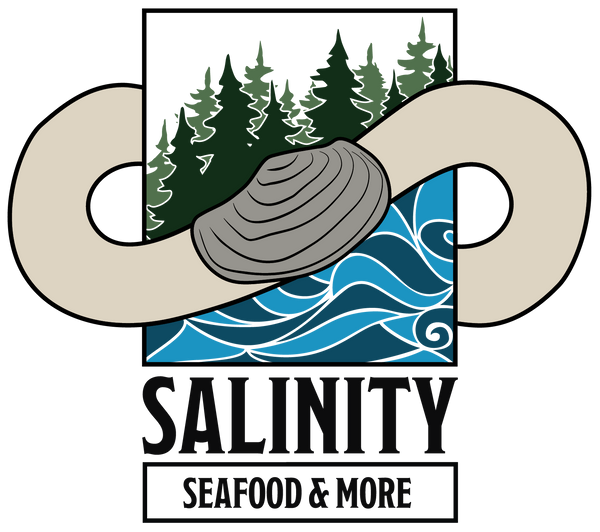WHOLESALE
Salinity provides wholesale oyster delivery locally to restaurants & shops on Whidbey Island, WA and across the U.S. with overnight shipping. Salinity works with two small shellfish farms in north Puget Sound, WA, Swinomish Shellfish & Skagit Shellfish.
Please email yourfriends@salinityseafood.com a copy of your reseller’s permit (sometimes called a resale license) and a brief description of what you need (how much, how often, for whom).
Salinity also works with Inland Foods, so you can add to your current account with them or start a new one.
Thursday shipping across the USA. Order by midnight Sunday for that week's deliveries, schedule in advance, or set up a recurring order. Payment in advance required. Shipping charges are based on the estimated weight of your shipment.
OYSTER INFO
Salinity works with two small shellfish farms in north Puget Sound, WA and a few dozen other small businesses on Whidbey Island and in the greater Pacific Northwest. The goal is to increase nationwide accessibility of their high quality, sustainably-made goods while providing folks with a rich education in merroir (oceanic taste of place).
Swinomish Shellfish Co. is the Swinomish Tribe's farm in Similk Bay off Fidalgo Island, WA. Similk is a medium salinity bay with impeccable water quality, very rich in nutritious microalgae. Their oysters get remarkable depth of flavor from growing in bags directly on their pristine beach. Bags are tumbled periodically by hand. Beautiful frilly ridges on their shells. Species: Olympia, Pacific (Kumamoto soon!)
Skagit Shellfish farms their oysters and soft-shell clams in Skagit Bay by Camano Island, WA. Due to fresh water influx from the nearby Skagit River, their oysters have a remarkably low salinity level. You can truly taste the oyster itself! Tide-tumbled in suspended bags for fat, firm meats and smooth, round shells. Very easy to open due to the shape. Species: Kumamoto, Pacific (Olympia soon!). Also available is softshell clam meat from their farm.
OYSTER SPECIES
Olympia (Ostrea lurida) - native to the West Coast of North America; very slow growing; taste sweet, mushroomy, coppery sometimes; harvested when between 1-2 inches (max size)
Kumamoto (Magallana sikamea) - native to southern Japan; slow growing (but faster than Olympia oysters); taste sweet, creamy, melony; harvested when between 1-3 inches (varies)
Pacific (Magallana gigas) - native to northern Japan; fast growing (similar to the East Coast native oyster); taste like cucumber
SALINITY
Oysters require brackish water (a mix of salt water and fresh water) in order to live. That is why you find them in estuaries or bays where water from a river meets water from the ocean. Because every growing region has a different water composition, salinity (dissolved salt) levels vary between farms and can vary between two oysters grown next to each other! Both Swinomish & Skagit farm in water that comes freshly into Puget Sound through Deception Pass, without passing any cities. In Similk Bay where Swinomish farms, that water is mixed with some fresh water. As the water enters Skagit Bay to the south, it is met with tons of cold, fresh glacial water from the Skagit River. This difference makes Swinomish oysters saltier than Skagit oysters.
GROWING METHODS
Not all oysters are grown on the beach. If the ground is too muddy, the oysters could sink and die. For aesthetic reasons, too, some farms will raise their oysters in bags on the ground or completely suspended above the ground using lines tied to buried cinderblocks. When they can be moved around by the waves in these bags, the oysters get the outer edges of their shells (the newest growth) broken off. This prompts the oyster shells to grow fatter instead of longer which results in a smooth, deeper cupped shell. Swinomish Shellfish does bag-on-beach growing, with refinement on the edges that still maintains that classic ruffled shell. Skagit Shellfish raises their oysters entirely in suspended bags (the ground is too soft for ground-growing) so they end up with very rounded, ridge-less shells.
